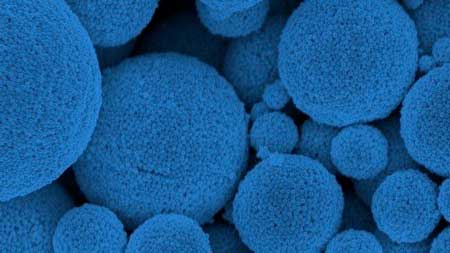| Dec 12, 2019 | |
Scientists harvest energy from light using bio-inspired artificial cells(Nanowerk News) By replicating biological machinery with non-biological components, scientists have found ways to create artificial cells that accomplish a key biological function of converting light into chemical energy. |
|
| In a study from Argonne National Laboratory, scientists created cell-like hollow capsule structures through the spontaneous self-assembly of hybrid gold-silver nanorods held together by weak interactions. By wrapping these capsules’ walls with a light-sensitive membrane protein called bacteriorhodopsin, the researchers were able to unidirectionally channel protons from the interior of the artificial cells to the external environment. | |
| “Nature uses compartmentalization to accomplish biological functions because it brings in close vicinity the ingredients needed for chemical reactions,” said Argonne nanoscientist Elena Rozhkova, a corresponding author of the study (Angewandte Chemie, "Light-Gated Synthetic Protocells for Plasmon-Enhanced Chemiosmotic Gradient Generation and ATP Synthesis"). “Our goal was to replicate nature, yet use inanimate materials to probe how cells accomplish their biological tasks.” | |
 |
|
| This scanning electron microscope image was taken of artificial “protocells” created at Argonne’s Center for Nanoscale Materials, which have the ability to convert light to chemical energy through the use of a light-harvesting membrane. (Image: Argonne National Laboratory) | |
| Because the bacteriorhodopsin is arranged on the capsules’ surface in an oriented manner, the protons that are pumped out by the bacteriorhodopsin eventually form an electrochemical gradient, where regions of high proton concentration develop outside of the cell. | |
| The key to the research, according to Rozhkova, came from coupling the group of artificial cells that were generating protons to a second, distinct group of artificial cells. These cells contain molecular motor machinery that uses the proton gradient to generate a molecule called ATP, which is well known as the fundamental unit of energy currency in biological systems. “We measured ATP in biologically significant concentrations upon exposure to visible light,” Rozhkova said. | |
| “The whole idea is that you have two systems that are communicating with each other,” added postdoctoral researcher Zhaowei Chen, the first author of the study. “One responds to light and pumps the protons, while the other uses this proton gradient to produce ATP, converting light into energy that is stored within a chemical bond.” | |
| By using protons as exchangeable ions, the scientists were able to construct a pathway by which two different groups of artificial cells could communicate. “By using a minimalistic artificial cell, we’ve stripped away pretty much all the major cellular functions, leaving behind only the basic function needed for communication and synthesis of energy-rich carrier molecules,” said Argonne biophysicist Philip Laible, another author of the study. | |
| The notion of modeling cellular communication with bioinspired materials is of special interest to scientists as they attempt to reproduce more complex biofunctional systems. “Some of our ideas for future experiments involve extending these capsules so that they resemble artificial neurons,” added Argonne nanoscientist Chris Fry. | |
| According to Rozhkova, the proton gradient represents only one example of an electrochemical signaling pathway that could be created using these artificial cells. “Conceivably, you could have sodium ions or calcium ions as the medium of exchange,” she said. | |
| One additional benefit of the inorganic support is that metallic nanoparticles act like a lens to focus and amplify the incoming light near the light-harvesting protein, leading to enhanced biological function. | |
| In addition to the experimental work, which was conducted at Argonne’s Center for Nanoscale Materials, Argonne researchers simulated the photonic properties of the artificial cells, as well as how they assembled. |
| Source: Argonne National Laboratory | |
|
Subscribe to a free copy of one of our daily Nanowerk Newsletter Email Digests with a compilation of all of the day's news. |
